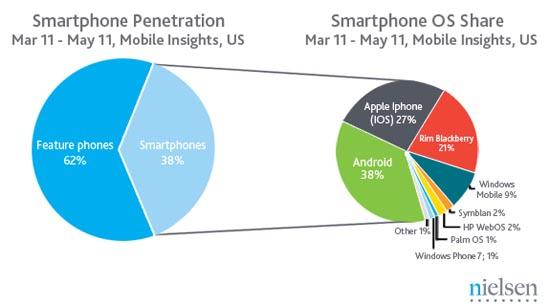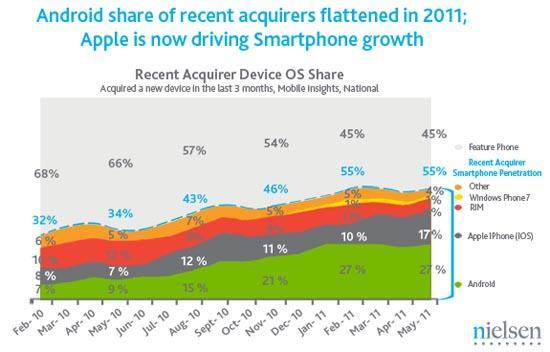
It's that time again, folks. Time to grab an ice cold drink (or hot cup of coffee at this time of the morning), sit back, and examine some market share numbers. Nielsen just released its latest survey on the mobile industry and, while some aspects of the report aren't terribly shocking, there are some interesting findings that are worth mentioning. First up is the overall market share at the end of May, which found Android as the leader with 38 percent of the U.S. smartphone share. The iPhone managed to snag a 27 percent share and RIM finished third with 21 percent. Rounding out the list, we've got Windows Mobile at nine percent, Symbian and webOS at two percent apiece, and Palm OS, Windows Phone 7, and the mysterious Other category at one percent each.
Next up is the information contained in the graph below, which shows what kind of device recent handset buyers selected over the past three months. Leading the charge once again is Android, which made up 27 percent of recent device purchases, although it's worth pointing out that Google's platform hasn't seen any growth in the category since early this year. A platform that has seen plenty of growth among new handset buyers is iOS, which grew from 10 percent in February to 17 percent at the end of May. RIM finished with a six percent share of recent buyers, down from 10 percent in February, while Windows Phone 7 finished at one percent.
Moving on to the eternal battle between smartphones and featurephones, we find that while the latter is still winning the overall fight, the former is becoming more and more popular among consumers. In the three month period ending in May, featurephones owned a 62 percent market share while smartphones controlled 38 percent of the market. However, the report also shows that 55 percent of consumers buying a new phone in the past three months chose a smartphone (up from 34 percent a year ago) while 45 percent opted for a featurephone.
Although Android is still far and away the smartphone leader here in the States, it's interesting to see the iPhone attain such growth over the past few months. No doubt that that surge is thanks at least in part to the arrival of the Verizon iPhone. As for the smartphone v. featurephone fight, I don't think the fact that consumers are adopting more advanced devices comes as much of a shock. As we've seen, smartphones are becoming easier to use than they've been in the past, and they're also getting much more affordable thanks to free on-contract Android phones and low-cost iPhones on AT&T. What do you all make of Nielsen's report? Do you find that more people in your life are ditching their featurephones and adopting smartphones?

Via All Things D, Nielsen